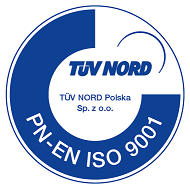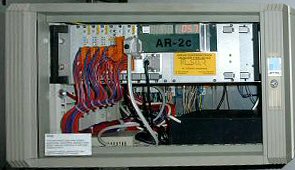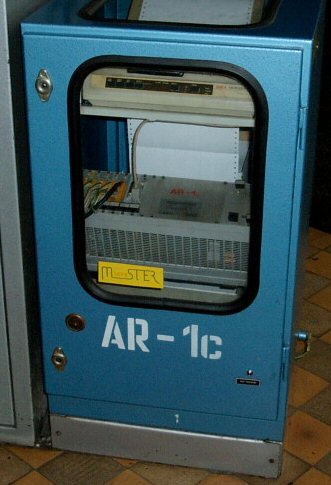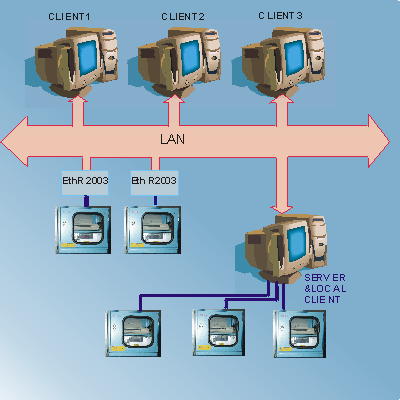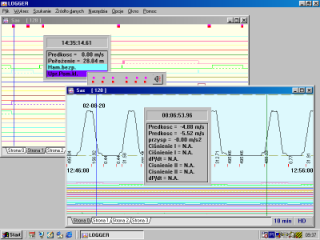The AR-2c Datalogger
GENERAL CHARACTERISTICS
Digital Registers AR-1c and AR-2c are microprocessor controlled devices destined for registering of different electrical and non-electrical - through appriopriate sensors - parameters. Although they were originally designed for registering status of mining winding gear they can well enough serve to cooperate with many other devices and machines. The devices are fully approved by the Main Mining Office (WUG GM - 174/93 and GM - 241/94).
PRINCIPLES OF OPERATION
The registered data are graphically represented in printed form. All parts of AR-1c and AR-2c are built in a dust-proof metal case and can co-operate with the OKI 280 Microline printer. Thanks to incorporating of digital display, two switches and two buttons it is easy to operate by the user. The registers can register bell signals by the means of acoustic sensors what gives the possibility of printing the information of real bell sounds which have reached the shaft machine operator's ears. For the Digital Register AR-1c uses the printer only shortly after some input signal had changed its state it saves both the paper and the printer itself. Depending on the version it can be entirely resistant to power down conditions. All inputs are fully insulated what makes connecting input signals easy. Two different independent Watch-Dog circuits work within the device what enables its safe work and causes the shaft machine's blockade in case the register can't accomplish its functions.
DIGITAL REGISTER AR-2c
Digital Register AR-2c is an extension of Digital Register AR-1c. It fulfils all functions of AR-1c and additionally all collected data is recorded in a condensed form within the register internal events' memory. This can be , if necessary , printed out by local printer in form of so called 1-minute ''local printouts'' or relayed to a connected IBM or IBM-compatible personal computer , and there , by specially designed programme , it can be analysed and printed in the systematic manner. When the IBM computer works as a part of intranet all data transmitted from AR-2c are available in mine's local net or internet.
Up to 64 digital and 16 analog input signals can be connected to Digital Register AR-2c. Thus many additional important parameters as currents in machine's circuits or pressure of breaks' media can be registered in AR-2c. It registers binary inputs with scanning rate of 100Hz and analog inputs with scanning rate of 10 Hz.
It also is equipped with a simple control panel consisting of a digital display and several switches and push buttons, what enables easy operation to change the device's internal time, produce local printouts and other service purposes. The display itself serves for displaying the registered data range, actual speed and cage position ( position pointer function) within the shaft (in case the AR-2c register collects the pulses from an encoder to determine the speed and position). Due to its structure AR-2c is able to obtain the status of two winding gears simultaneously. It is also equipped with a two-channel RS 232 serial link for visualisation, registering of safe break circuit status or service purposes.
Digital Register can be connected with an IBM or IBM-compatible Personal Computer by the means of a serial link operating on RS 232 standard or current loop , or by the means of telephone modem connection for distance exceeding 1000m. The IBM computer in order to operate with the register or with several registers has to be equipped with Microsoft Windows ver.3.1. (or above) software and with a customised "LOGGER" programme. With assistance of this programme one can view many registering machines simultaneously. One can compare them , store data on hard disc or printout selected fragments of any chosen register.
Additionally when connected to an IBM personal computer and provided with a special MONITOR programme it enables to observe the work of the winding gear in the ''real time'' mode.
Additional factor which distinguishes AR-2c from AR-1c is that it is fully independent from the local printer work.
CONFIGURATION
Each AR-2c can work in any of the following configurations:
- configuration with local printer
- configuration with IBM computer
- network configuration
- mixed configuration
INTERNAL EVENTS MEMORY
Internal Events Memory is a kind of electronic disc with capacity of 1,5 to 4MB - depending on the needs. It enables storing registered data of more than 8 days of the winding gear's work but under normal circumstances it is capable to store the data of more than one month or longer. Its construction protects both from unexpected loss of data or accidental write.
LOGGER PORGRAMME
The LOGGER programme is dedicated for visualisation of data obtained from one or multiple AR-2c registers via serial links. The data can be transmitted and stored in computer hard disc in form of one-day archives. It is also possible to ''on line'' viewing of the contents of any AR-2c register connected or to print any data on the system printer.
For a user-defined report function is implemented within the LOGGER programme it is possible to random define and create different reports as needed.
NETWORK FUNCTIONALITY
If a new LOGGER ver.3. is implemented on any PC which works as a client net station and the LOGGER - server ver. 3.0. is introduced to the computer-server station which additionally is equipped with serial links to one or multiple AR-2c registers the data obtained can be viewed in whole net or even in Internet.Such configuration is illustrated on opposite scheme. Additionally it is possible to equip the register with a special net module called EthR2003 which converts the RS232 signal into ETHERNET standard. Having done so one can connect AR-2c directly to the LAN as a net server.
PARAMETERS
| PARAMETER DESCRIPTION | PARAMETER VALUE | |
| 1 | 2 | |
| Power supply | 24V - 28V AC or DC or 240V AC | |
| Power supply tolerance | -15%; +10% for (240V) | |
| Power consumption | no more than 50VA | |
| Ambient temperature during work | 5 - 40oC | |
| Ambient temperature during transportation and storage | -40oC - +70oC | |
| Relative humidity at 30°C during work during transportation |
30...85% do 95% |
|
| Dimensions | 480 × 254 × 134 mm | |
| Weight | 7 kG | |
| Registration time after power down | no less than 1 hour** | |
| Binary inputs | quantity | 20 - 188 |
| input voltages | 24 V, 48 V, 220 V, 110 V DC | |
| input voltages tolerance | ±35% | |
| input currents | 4,5 - 10 mA | |
| scanning resolution (frequency) | 10 ms | |
| isolation | 2500 V | |
| Analog inputs | quantity | 8 (16) |
| input voltages | -10... +10 V -20... +20 V -100 ... +100 V |
|
| registered currents range | -20 ... +20 mA | |
| measured voltages type | AC & DC | |
| scanning frequency | 100 ms* | |
| measurement accuracy | 12 bits + sign bit | |
| registration accuracy | 8 bits + sign bit | |
| isolation of measurement channels | 2500 V | |
| Acoustic inputs | quantity | 2 |
| registration resolution | 20 ms | |
| Counter inputs | quantity | 1 |
| Outputs | quantity of relay outputs | 2 |
